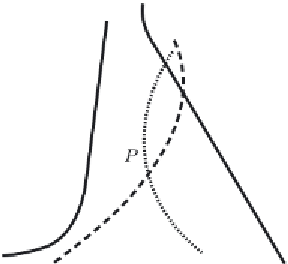Geoscience Reference
In-Depth Information
Figure 11.3 The nondimensionalized (with
w
∗
and
z
i
) TKE budget in a quasi-
steady, horizontally homogeneous CBL as summarized by
Lenschow
et al
.
(
1980
)
from a variety of observations.
, viscous dissipation;
T
, turbulent transport;
P
,
pressure transport;
S
, shear production;
B
, buoyant production.
If the mean velocity scale is
U
and the velocity and length scales of the turbulence
are
u
and
, the ratio of the friction and Coriolis terms in
Eqs. (11.3)
is
u
2
/f
U
,
U
=
a
Rossby number
. In a typical ABL with
u
=1ms
−
1
,
f
10
−
4
s
−
1
,
=
10 m s
−
1
,and
10
3
m this Rossby number is
1, so the Coriolis terms are
typically important. But the much smaller
in engineering flows typically makes
their Rossby number large and their Coriolis terms negligible.
In a constant-density engineering boundary layer the pressure field, and in partic-
ular the mean pressure gradient, is coupled with the velocity field through a Poisson
equation
(Problem 11.15)
. But in the ABL the mean pressure gradient is dominated
by hydrostatics
(Chapter 9)
. Thus if we convert
Eq. (11.3)
to a mean-shear bal-
ance by taking its
z
-derivative and express the
z
-derivative of the mean horizontal
pressure gradient through
Eqs. (9.29)
and
(9.30)
,wefind
=
∼
∂
2
uw
∂z
2
∂
2
vw
∂z
2
g
T
0
∂T
∂x
+
f
∂V
g
T
0
∂T
∂y
−
f
∂U
=−
∂z
,
=−
∂z
,
(11.4)
We'll see shortly that
Eqs. (11.4)
can imply strongly curved stress profiles in an
ABL with a modest horizontal temperature gradient.
11.2.3.1 The barotropic case
With horizontally uniformmean temperature the mean shear budgets
(11.4)
reduce,
after scaling with
u
∗
and
z
i
,to
∂
2
(uw/u
2
fz
i
u
∗
z
i
u
∗
fz
i
u
∗
z
i
u
∗
∂
2
(vw/u
2
)
∂V
∂z
,
)
∂U
∂z
.
∗
∗
=
=−
(11.5)
∂(z/z
i
)
2
∂(z/z
i
)
2































































